https://www.youtube.com/watch?v=NGucNJ67_wg
How to Manage the Fire in a Cheap Offset Smoker (COS)
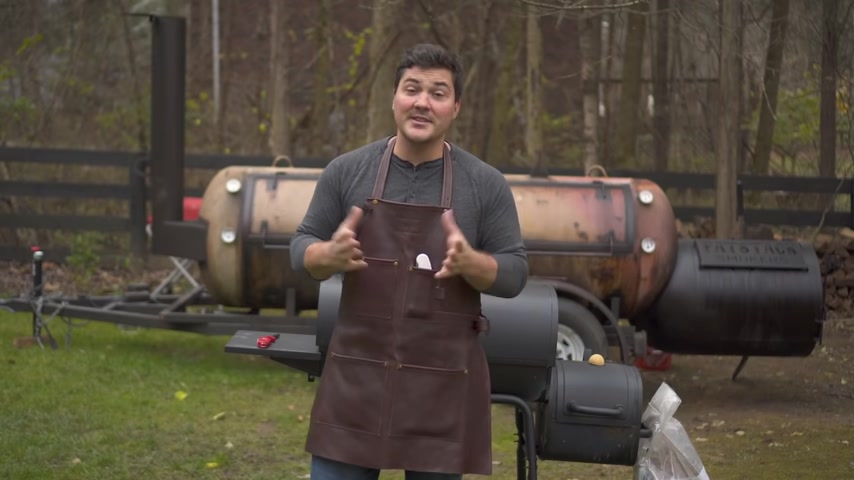
Hey guys , welcome to Mad Scientist barbecue .
I'm Jeremy Odor .
And today I'm going to answer a question that I've gotten over and over and over again .
Today .
I'm going to show you how to manage your fire if you own a cheap offset smoker .
I view this video as one of the more important videos that I've ever made because there are so many people out there who have a smoker like this and not one like the one in the back there and they need to know how to manage their fires so they can make great barbecue without spending thousands of dollars on an expensive smoker .
It may seem counterintuitive but using a small offset smoker like this , especially one with thin metal is much harder than using something like that .
500 gallon smoker in the background , the 500 gallon is much easier to burn a clean fire because there's so much heat in the coal bed there that you can put in big pieces .
You don't have to have the logs arranged perfectly or anything like that and it will just burn them up and produce pretty clean smoke .
Now , there can the great smoke that you produce or pretty good smoke .
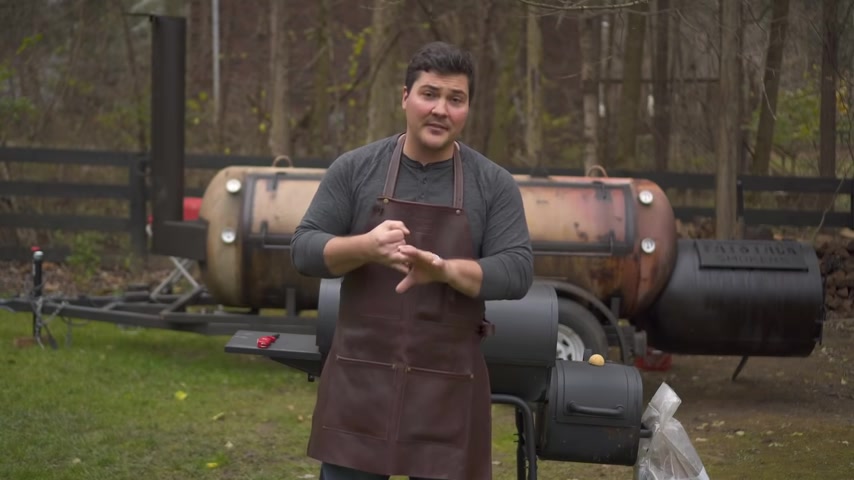
But generally speaking , there's a lot of forgiveness when you use a big offset with these small offsets , all that forgiveness is taken away .
It is a cruel master and you have to be incredibly diligent about how you manage that fire because if you're not , then your fire is going to get choked off and you're not going to produce the kind of flavors .
That is the whole reason why you're barbecuing on an offset in the first place .
Now , what we're gonna do in this video is pretty simple .
I'm gonna teach you how to start the fire , how to maintain the fire , the temperature and the smoke correctly .
And then I'm gonna teach you what to do when you're done with the fire and you need to walk away .
So here I've got a chimney of lump charcoal .
I prefer lump charcoal .
I think it burns a little hotter .
Works better to light the wood that we're gonna add .
And then also there are no adjuncts or fillers or binders or anything like that besides just pure charcoal .
Now , to light it , I have a starter here .
You can use different kinds .
You can use those little white cubes that people like you can use the tumbleweeds .
You can use those things that look like little boards that you break off and like doesn't matter .
This is the one I'm going to use today and we're going to get this thing lit and put the coals over the top of it .
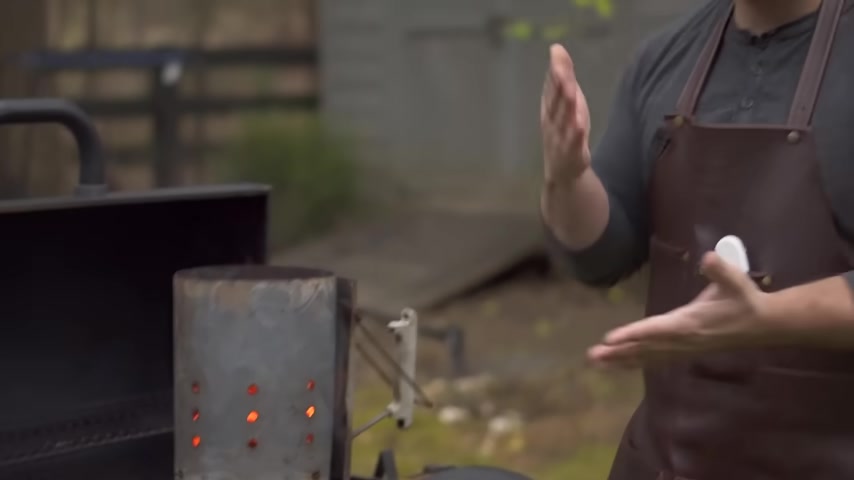
And after about 15 minutes , we should be ready to go .
Ok .
We got flames shooting out of the top of this chimney and it's starting to get white ash on the coals that are on the very top .
That tells me this thing is ready to go .
So I'm gonna pick it up , pour it into the fire box .
Now , I wouldn't recommend lighting your charcoal chimney on this grate , but I didn't really have anything else to use today .
If you have some concrete , you don't mind messing up .
But for me , this is the thing that I didn't mind messing up .
So I started it there .
Now , after we have our coals in , now it's time to start adding wood .
And so I have a bag of wood I got at Cabela's and I'm going to cut that open and see what we're working with .
When you buy a bag of wood , you'll run into some issues .
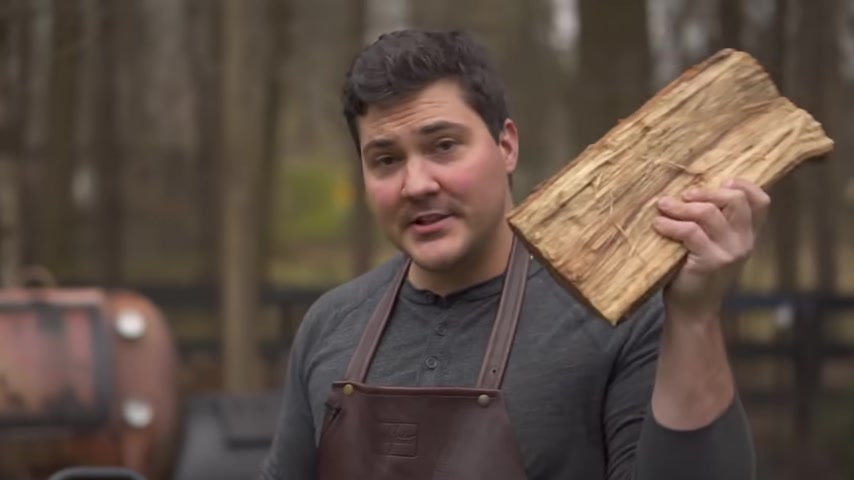
So in this bag of wood , I have this piece and this piece , this one I could probably use , it might be a shade bigger than what I like .
But we can totally use this , this one .
There's not a chance I can use this .
It is humongous and I need to cut this down and you're probably going to run into that issue no matter where you get your wood .
So I'm going to take this over and split some of this down so that we have pieces that are appropriate for this size of smoker .
So those two pieces of wood I've now split into 12345678 pieces .
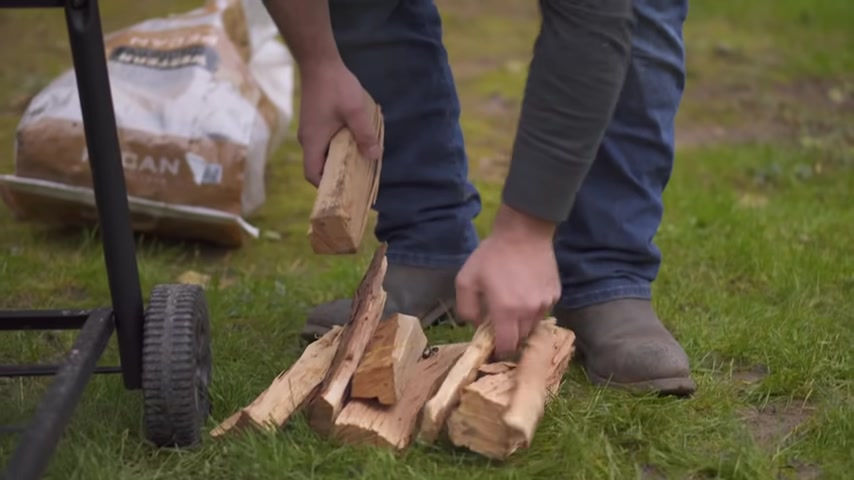
So these are a more appropriate size for the size of the smoker , right ?
So I'm gonna start with these two pieces because generally speaking , you want to get your fire hotter than you want and then let it settle down into cooking temperature .
The reason for that is two fold , number one is , you know that you're not gonna have a wild swing up when you put your meat on first and then second is you build a bigger coal bed to maintain that fire for longer .
At this point , I'm gonna leave the door to the fire box and the door to the cook chamber open because I don't want any of this white smoke that you see right here to go through and , you know , deposit on the grapes or anything like that .
Also , I want as much air to move past that as possible so that I get an open flame and I'm not depriving it of oxygen .
In addition , I have these vents on the fire box wide open , but I'm not only going to do that , I'm actually going to pull out this draw some .
So I get plenty of air flow more than I think I need .

Because if there's too much oxygen that's not a problem .
If there's too little oxygen , that's a big , big problem .
These two logs are now burning an open flame that tells me two things , fire is healthy .
And number two is I'm producing clean smoke , which is going to make great tasting barbecue .
So I want to get the air to start drafting through this thing .
So I'm gonna close the fire box door .
Then I'm also going to close the main cook chamber door because I want this metal to heat up because when the metal heats up , it's going to draft better .
Because if you don't allow the metal to heat up , the hot air from the fire box will come in here , it will cool down and no longer escape through the chimney as well as it would if the metal were already hot .
Now , one quick tip , if your wood feels kind of heavy , that is , it has still quite a bit of water in it .
You can preheat these pieces of wood by placing them on the fire box .
So you place them on there , they get hotter and they ignite more easily than if they're still cold .
And also if you leave them on for a while , you can actually drive water out of the wood and you have a better burning fire .
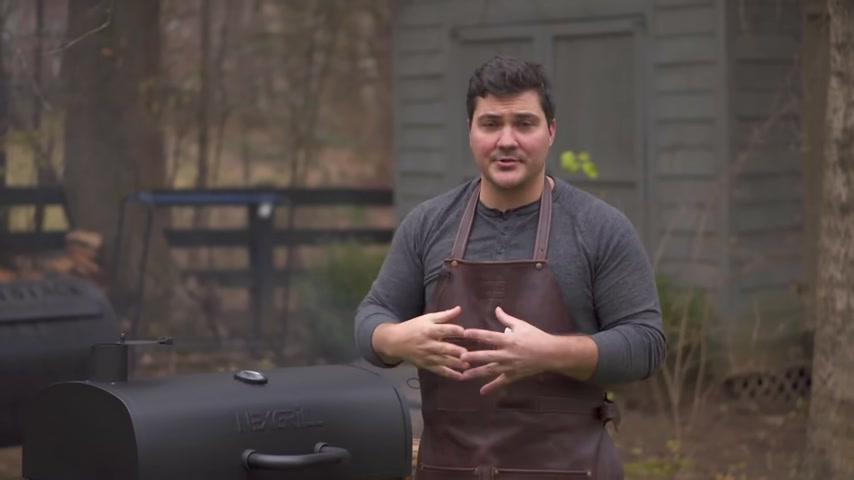
At this point , I'm starting to be concerned about temperature .
So I'm going to monitor the temperature because I want it to go up high and then come back down and settle in to a good cooking temperature .
And on a smoker of this size , I would recommend something around 250 degrees and you're gonna have fluctuations because this is a live fire and you have to manage it yourself .
So it might get as high as 2 75 or as low as 2 25 .
But if you keep it in that range , it's still brisket weather inside that cooker .
So I don't trust the gauge on top of the smoker , it's already filled with water , it filled with water condensation .
Rather , I think the second day I ever had this thing .
So what I do is I use the thermal works , smoke X four .
So this is four channels and it's got a remote receiver .
So you can be inside and you can be monitoring the temperature of your pit .
So you don't have to stay out here 100% of the time .
And it's got , I think a one mile range on this .
So that's great .
So I can be in the basement and still get signal from the smoker that's outside .
Digital probes are much more useful than analog thermometers in my experience .
Now , there are some exceptions .
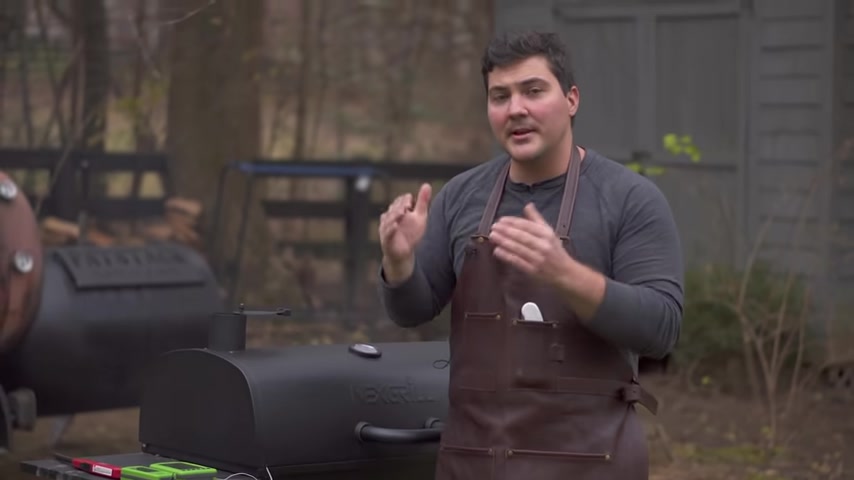
If you have t true or a brand that's really high quality , those are very useful .
But the gold standard is always going to be a digital probe to illustrate the difference between this analog thermometer and the digital probe .
I have inside , on great level .
This one is reading well over 400 degrees actually .
With the con no , it's reading well over 500 degrees .
Whereas the digital probe right now is right about 415 .
So that's a big difference when the temperature of the smoker goes down to about 250 degrees .
The difference between what you're reading with the digital probe and what you're seeing on this analog thermometer might be a smaller difference , but it's still going to be a big enough difference to make a difference in the outcome of your barbecue .
Now , all I'm going to do is wait for this temperature to settle down into about 250 degrees .
And then we're going to work with the fire and then if we were cooking meat today , we would put it on .
So at this point , the fire has kind of burned down .
It's mostly coal .
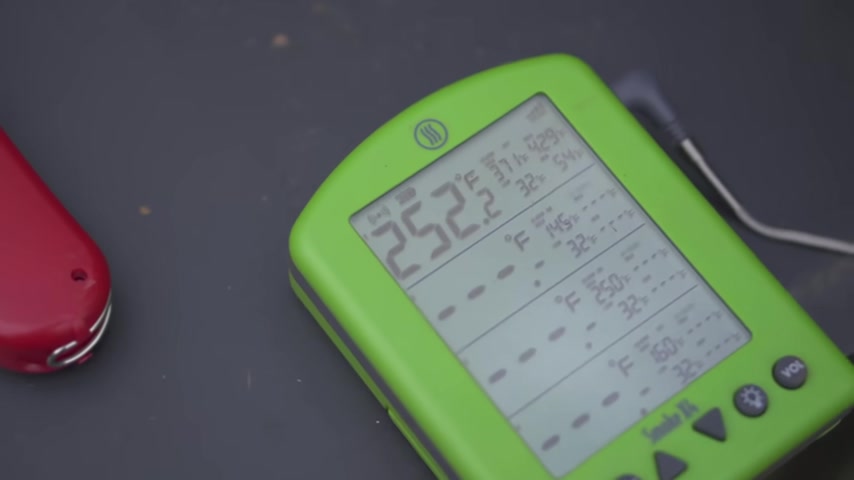
And so it's time to rearrange those coals so you can shake off some of that ash that's present on the outside , so it can still continue to burn hot .
So I'm going to get in there and move them around and at this point it's time to add another log because the temperature has dropped to 252 degrees .
Now , when you add a new log , the temperature doesn't immediately spike everything moves on a curve .
So when it's going down , I want to add wood before it gets too cool so that I don't lose too much temperature and the fire gets too cold that I don't produce the kind of smoke that I want .
When I put a new log on to deal with the fire on a smoker of this size , I like to use long handled metal tongs because then I can grab logs , move them around , grab coals , move them around .
It's just a really convenient way to do it .
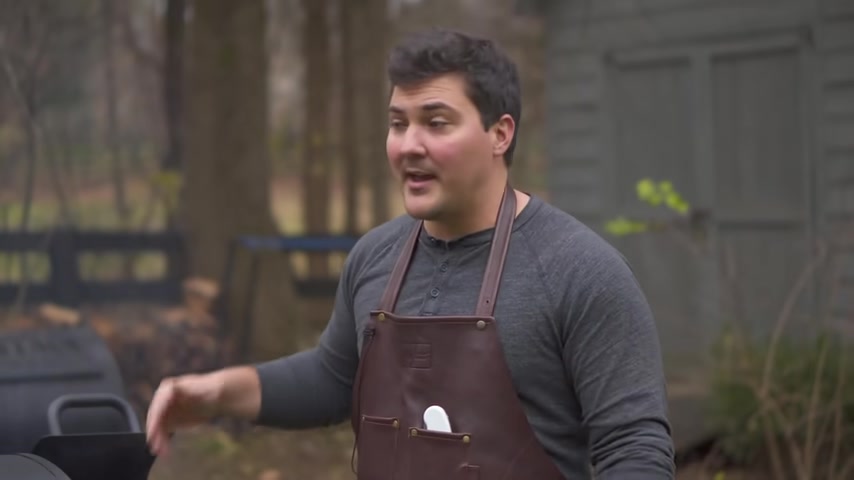
Also , I'm going to leave the fire box door open as long as it takes for that piece of wood to burst into open flame .
At that point , I close everything down again and I keep cooking with cheap offset smokers .
We have one thing that we're going to do differently than if we have a quarter inch stick offset .
That's a backyard size and it's very different from what we would do with a 500 gallon offset .
Here .
We're going to add unlit lump charcoal .
And the reason for that is if you look at the fire right now , most of the coals have burned away and the piece of wood that's in there isn't burning super strong .
So I need to add more coals because I don't burn enough wood in a smoker of this size to generate a sufficient coal bed to keep the thing going .
So I have some coals in this chimney right here .
I'm going to pour them on top of the existing coals and those will start to light .

And at that point I can continue to add more wood with a sufficient coal bed to get clean smoke with the coals in there .
Now , you see that there's a bunch of white smoke coming out of there .
Now , I've never noticed any off flavors with the unlit charcoal being put in there .
It's possible you might get them .
So , what I do to try to minimize any off flavors that might occur is I leave this fire box door open until the coals get lit .
Well , and then I have good clean smoke coming out of here .
I close it back down .
Now to speed the process , you can actually kind of blow on the coals with lump charcoal .
You want to be a little careful because it can spark and crack and you can get sparks that fly in your face .
That's happened to me plenty of times .
But if you're willing to deal with that , that's ok .
My little brother , he has a smoker about this size and he actually uses an electric leaf blower and just points it toward the coals .
They get screaming hot .

He puts on the next log ready to rock and roll and that should be good .
The final part of fire management is what do you do when you are done cooking ?
But you still have a fire going .
There are different ways .
People have tried , some people shovel out all the coals , put it in a metal garbage can put the lid on top and smother it that way works .
But it's more trouble than I think most people are willing to go through .

Some people try to close all the vents down and shut everything down and smother the fire while it's still in the smoker .
Number one , you're going to trap a bunch of nasty gross smoke inside your smoker , which you don't want .
And number two is , it doesn't really work very well because especially on a smoker like this , there are leaks , there are holes , air is going to get in and that fire is going to continue to burn very slowly .
So you might have coals that are still hot two or three days later and you might go in there and reach in , try to scrape out all those ashes and burn yourself pretty badly .
You do not want that to happen .
Instead , what I recommend people to do is open everything up and let all the oxygen in the can and let the fire burn itself out and then you only have ashes remaining so that you can come back the next day and just clean everything out .
So open that up , open this up and walk away .
Now , if it's super windy , you don't want to do this or if you live in some place that's really dry , you probably don't want to do this .
But for most people across the country , this is the easiest way to let your fire go out and make it easy to clean your smoke or when it's time to clean it up .
So let's review what we've covered here .
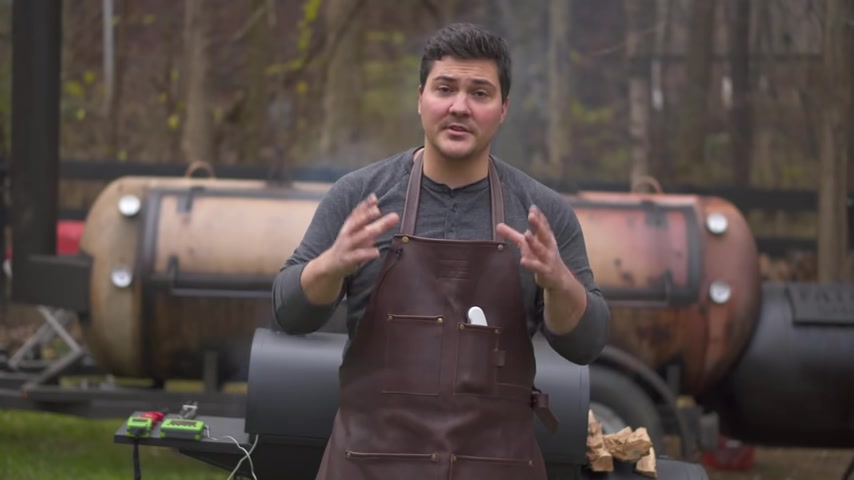
Number one , you want clean smoke to get clean smoke , you have to choose pieces of wood that are small enough or split them down so that they're small enough that when you put them on the fire , they're gonna burn cleanly and that is burn with lots of oxygen .
You want the vents wide open .
So that the kinds of compounds you make are the flavorful compounds that make barbecue so special .
Also , you have to maintain a big enough coal bed because if the coal bed dies , your fire is essentially dead .
So the heart of the smoker is the fire box and the heart of the fire box is the coal bed .
The coal bed is crucial .
You gotta keep that thing going to that end .
You have to do two things .
You have to have two fuel sources .
In this case , we have wood and we have charcoal .
The charcoal is primarily for heat and to keep the coal bed going , the wood is for smoke flavor .
So we're going to continually add charcoal to the fire box and add wood as one piece burns out .
The charcoal keeps the coal bed going .
The wood provides flavor that makes barbecue so much fun to do .
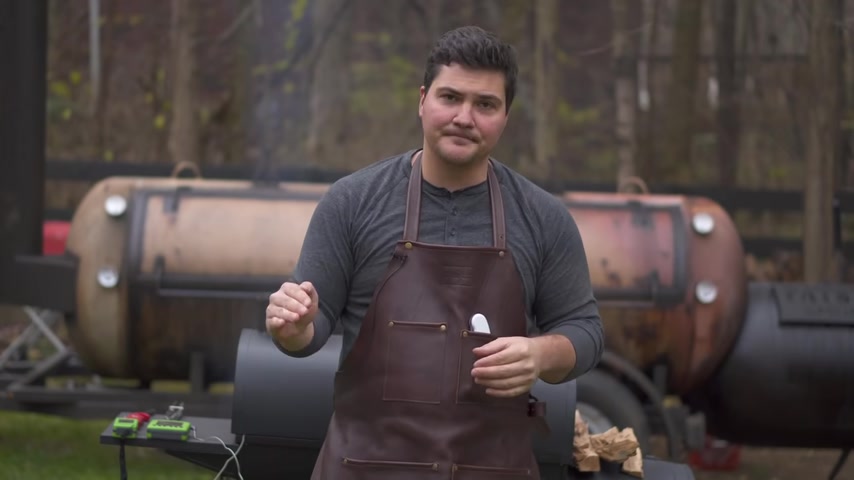
The third thing you have to keep in mind is consistent temperature earlier , I told you that everything moves on a curve when it comes to temperature .
So what helps you is if you act before you think you need to .
So if you want to keep the temperature at 250 degrees and it's coming down and hits 2 52 2 51 2 50 .
I wouldn't wait around for it to hit 2 25 .
I would add a piece of wood or add some charcoal to increase the heat because it's gonna go lower than 2 50 then work its way back up .
So , adding stuff before you think you need to is going to be the most helpful way to deal with those swings that are on that curve of temperature you're gonna deal with and you're gonna fight against for the whole cook .
If you follow these principles , you're gonna be able to make incredible barbecue in your backyard and you're gonna have to spend thousands of dollars to get a custom , you know , 500 gallon pit to do it .
To me what barbecue is , is cooking meat with a real fire .
This is a real fire and it's going to take a lot of work to make it good .

So if you're diligent about monitoring this fire and you're willing to spend a lot of time out here and fiddle with it and blow on it and check on it and nurture it along , you're going to be able to make incredible flavors and it's going to blow the socks off of anybody who's used to eating stuff cooked on a pellet grill or some other inferior method of cooking to people who use pellet grills .
It's just for me , offset .
Smokers are kind of the pinnacle of flavor that you can achieve in barbecue and even with an inexpensive one , you can make incredible stuff .
Thank you guys for watching .
If you have ideas for more videos you'd like to see , please leave them in the comments below .
And if you find this video to be helpful , like the video , subscribe to the channel and turn the notification bell on .
So you get notified whenever I put out a new video , you can also follow me on Instagram and Twitter at Mad Scientist Barbecue .
I'll see you guys next time .
Are you looking for a way to reach a wider audience and get more views on your videos?
Our innovative video to text transcribing service can help you do just that.
We provide accurate transcriptions of your videos along with visual content that will help you attract new viewers and keep them engaged. Plus, our data analytics and ad campaign tools can help you monetize your content and maximize your revenue.
Let's partner up and take your video content to the next level!
Contact us today to learn more.